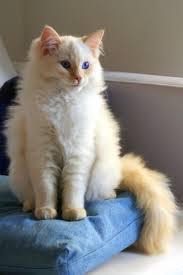The Ragdoll - A Relaxed, Friendly Cat Breed
 In 1990 I adopted a lovely two-year-old orange and white longhaired cat. Her name was Ama and when she came home with me I didn’t change her name – nor did I ever find out why she was christened so. Her elderly owner had passed away and she was brought to the Bozeman (MT) Humane Society. Her round face and elegant coat gave her a royal look – she didn’t belong in a small cage. As I neared her little prison, she reached a paw out to me, like a damsel in distress. Ama graced my home for more than 15 years, passing in 2006 at age 18 from kidney failure.
In 1990 I adopted a lovely two-year-old orange and white longhaired cat. Her name was Ama and when she came home with me I didn’t change her name – nor did I ever find out why she was christened so. Her elderly owner had passed away and she was brought to the Bozeman (MT) Humane Society. Her round face and elegant coat gave her a royal look – she didn’t belong in a small cage. As I neared her little prison, she reached a paw out to me, like a damsel in distress. Ama graced my home for more than 15 years, passing in 2006 at age 18 from kidney failure.When my friend Cindy Cartier visited a few years after I adopted Ama, she picked up my light-weight kitty, and exclaimed, “She’s a ragdoll! Or part ragdoll anyway.” I replied, “No, she’s a cat.” That’s when I got an education on an amazing breed of cat.
Ragdolls are known for their docile, relaxed, and loving personalities. They go limp in one’s arms, hence the name. That’s what Cindy noticed first about Ama – her placid body and quiet demeanor. This breed of cat is very affectionate and does well with children and other pets. Ragdolls are known to be especially good with dogs – that’s something else about Ama: she and my cocker spaniel, Sam (whom I also adopted from the Bozeman Humane Society) got along incredibly well; they often lay on the couch side by side and never once had a spat. Ragdolls are like dogs in many ways, including the fact they can be taught to fetch and sometimes come when called.
Another trait of Ragdolls that manifested in my adopted girl is the fact they often walk on a leash. When I first brought Ama home, I didn’t want her outside on her own, but I also didn’t want to keep her cooped up during the warm, sunny summer. So, I thought I’d leash-train her. I didn’t have to – she either already had been trained or it was simply instinctual – she walked wonderfully well and never minded the leash. We had fun strolling the neighborhood for many years.
Female ragdolls are small, often five pounds or less – that was Ama, too; even as a spayed female she rarely weighed above six pounds. Altered males, however, grow quite large, up to 20 pounds in some cases.
This is a playful as well as friendly breed. They enjoy the company of their humans, sometimes following them through the house and greeting them at the door. They also enjoy toys and playtime with people, and they are great cuddlers on the couch or in bed.
The breed’s fur is quite soft, almost rabbit-like in texture. Though most have a medium-length coat and some shedding occurs, these cats require minimal grooming – a regular combing generally suffices. Their fur is easy to pick up and a damp hand or cloth will lift most Ragdoll fur from your clothes.
Coat colors are often light, and, similar to Siamese, feature points (face, ears, tail, and feet) of blue, chocolate, seal, lilac, red, and cream. Ama may have been considered having red points, but her entire body mingled orange and white, therefore, she would not have been a purebred Ragdoll. The breed is also noted for its deep blue eyes, again like the Siamese, and again, this is how Ama differed – her eyes, though striking, were a deep amber color. View photos of Ragdolls at http://www.rfci.org/info/color_pat/index.php.
According to Ragdoll Fanciers Club International, the breed developed by Ann Baker during the 1960s in California, a product of Persian and mixed breeds. The Ragdoll was recognized as a purebred in 1965 and has become a fast-growing, beloved cat breed. Learn more about Ragdoll cats at http://www.cfa.org/Breeds/BreedsKthruR/Ragdoll.aspx.
If the Ragdoll is a cat breed that intrigues you, remember the shelters and rescues first – think adoption. Go to www.petfinder.com and type in the breed name and your zip code – you’ll find a list of Ragdoll cats (or another breed you’re considering) and what shelter or rescue has them available for adoption. You’ll discover a treasure in a Ragdoll you adopt, just as I did nearly 25 years ago.
Published on February 18, 2014 08:25
No comments have been added yet.



